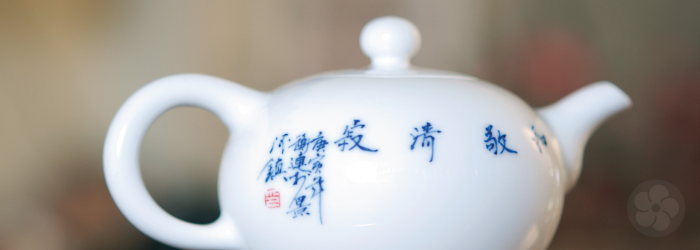Fine China: 4 Types of Porcelain Clay

Chinese pottery has a long history, and is an integral part of the foundations of modern China. One of the greatest early achievements of Chinese potters was the development of denser clay materials that could be fired at extremely high temperatures, resulting in stronger finished pieces. While Chinese tradition calls all of these high-fired clays ‘porcelain’ even today, English speakers typically think of porcelain as a bright white, fine-grained clay, distinctly different from more common ‘stoneware’ pottery. When used in teaware, this type of porcelain offers a white background that makes it easy to see the color of the tea and leaves, along with a light, easy-to-handle weight and a sharp pouring edge that prevents dribbles.
When Europeans first saw this type of clay during the Ming Dynasty, it came only from China, resulting in the nickname ‘china’ or ‘fine china’. Unable to replicate the material locally, European collectors paid extraordinary amounts for pieces made of the “white gold” from the exotic east. Even within China, this particular kind of clay was quite rare, coming mainly from the town of Jingdezhen, which grew rapidly with the fame of its white clay. Within China, the only clay called “fine china” is from Jingdezhen. Over time, imitation and experimentation have produced several different kinds of clay with a fine grain and white, translucent fired body - the key characteristics of high quality porcelain.
Hard Paste Porcelain
The original formulation of “fine china” was a specialty of Jingdezhen: a mixture of kaolin and petunse (pottery stone), both found locally in large quantities. While kaolin is now a primary ingredient of almost all porcelain clays and mined all over the world, the un-tinted white kaolin of Jingdezhen is still a rarity. A simple 50/50 mix with petunse fired at around 1400°C made the best white, translucent porcelain in the world.
Learn more about the unique porcelain of Jingdezhen >>
The high firing temperature made finished pieces in this clay extremely strong, despite their delicate appearance. The frenzy to replicate it in Europe continued for at least 150 years, until the Meissen factory in Germany started production of a hard paste porcelain in 1710. High firing temperatures help to vitrify the clay, making it more glass-like and resistant to staining, but they also make decor more difficult, as most pigments burn off in the kiln.
Soft Paste Porcelain
Early European iterations of porcelain, developed in Italy, France, and England, sought to imitate the characteristic translucency by mixing ground glass with clay. While these formulations imitated the look of Chinese porcelain, they were hard to work with and prone to collapsing in the hot kiln. Firing temperatures for this type of clay only reach 1100°C, and the surface of a finished piece is easily scratched.
Later versions of soft paste porcelain improved with the inclusion of hard paste ingredients like kaolin, and new additions like quartz. Today, many of the same ingredients are used in both types of porcelain, but they are easily distinguished by firing temperature. The lower temperatures used to fire soft paste porcelain still typically leave a surface that is more easily scratched and stained, but they also allow for more range in decorative color.
Bone China
In England, experiments with soft paste porcelain eventually led to a formulation that included local kaolin, petunse (locally called Cornish stone), and a new ingredient: bone ash, derived from cattle bones. Though the earliest documentation of this recipe comes from the 1740s, it would not become a commercial success until 50 years later, when the process for producing bone ash was streamlined. Today, bone china is typically made up of 25% kaolin, 25% petunse, and 50% bone ash.
Despite firing at lower soft paste temperatures, the proportion of bone ash makes this type of porcelain extremely strong, resistant to both chips and scratches. It is also strong before firing, allowing for extremely thin and delicate pieces to be formed. But the laborious multi-step process of making bone ash, along with the cost of other high-quality ingredients, also makes this the rarest and most expensive type of porcelain.
Paper Porcelain
To improve the workability of the clay before firing, potters working in both hard paste and soft paste porcelain often use pulp or cellulose fibers to make ‘paper’ porcelain. By mixing in fibrous material, they add significant strength to the wet clay. Though this technique can be used with any clay, it is commonly used for porcelain, a notably difficult clay to work with. The extra strength allows potters to achieve thinner walls and more delicate shapes without risking cracks or slumping during the forming process.
It is extremely easy to make a crude yet functional version of paper clay, and it can dramatically improve success rates, especially during the drying process, when delicate clays can crack under invisible stresses. Unlike bone ash, however, fibrous materials burn out of the clay during firing, and have no effect on the look or durability of the finished piece.
Porcelain teaware can often seem too delicate to handle, but in fact, it is the strongest clay formulations that allow for such thin walls. Good quality porcelain, whether it is rare bone china or a simple hard paste recipe, gained its reputation not only for its aesthetic beauty, but also for unmatched durability.
Do you brew in porcelain? What do you like (or not like) about using porcelain teaware? Let us know in the comments below!
Sign up for our newsletter to get blog updates in your inbox!








Comments on this post (0)